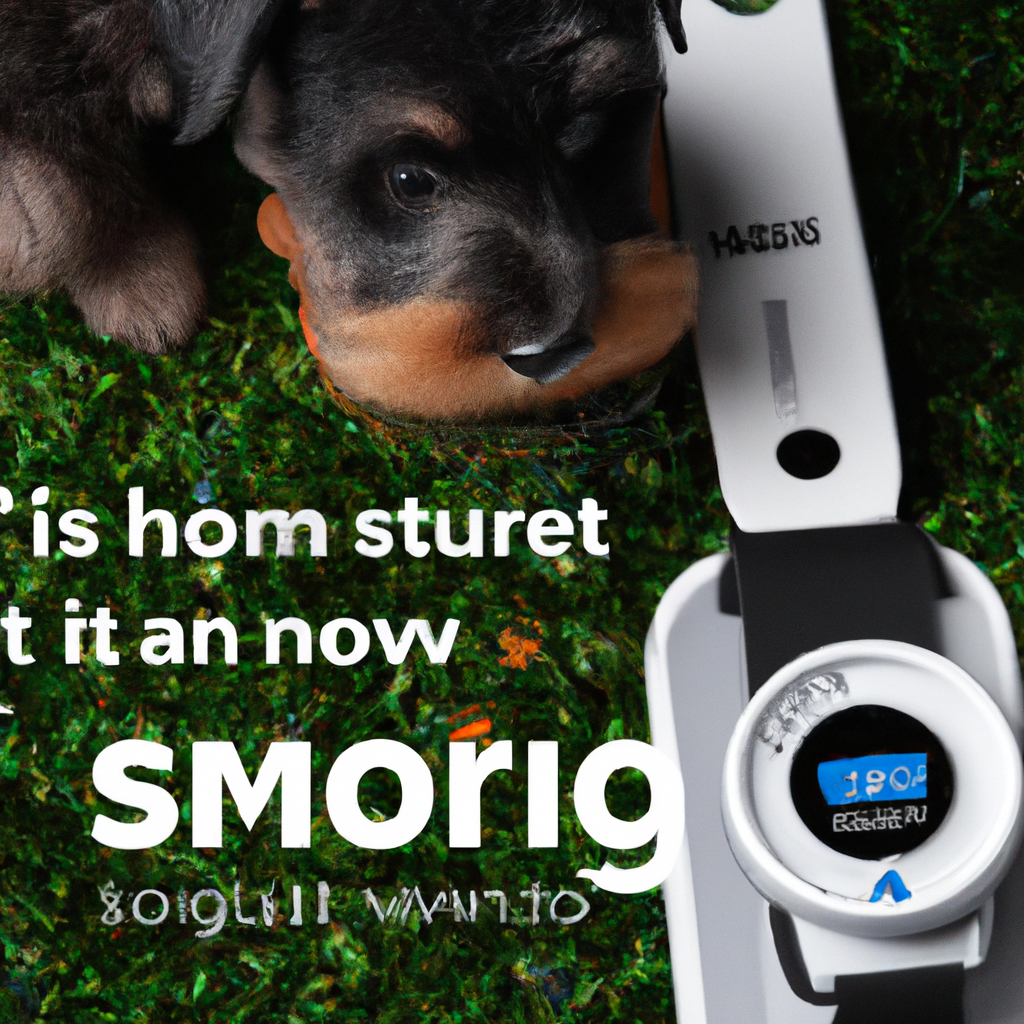Imagine living in a world where your furry companion is never truly alone, even when you’re away. Thanks to the wonders of technology, smart devices for pets have become increasingly popular. These innovative gadgets allow you to keep an eye on your pet’s activities and well-being, granting you a sense of security and reassurance. However, while these devices offer convenience and peace of mind, it’s crucial to delve into the privacy considerations that come with their usage.

Data Collection and Storage
Types of data collected by smart devices for pets
When using smart devices for pets, various types of data can be collected. Some common examples include activity data, such as the number of steps taken or calories burned by your pet. Some devices also collect health data, such as heart rate or temperature. Additionally, location data can be collected to provide features like GPS tracking. It’s important to be aware of the specific data that your smart device collects to understand how it may affect your privacy.
How long is the data stored?
The duration for which data collected by smart pet devices is stored can vary depending on the device and its settings. Some devices may store data for a limited period, like a week or a month, while others may keep it indefinitely unless manually deleted. It’s crucial to check the manufacturer’s documentation or privacy policy to understand how long your data is retained. Being aware of data retention periods allows you to make informed decisions about the potential risks and benefits of using these devices.
Security of the stored data
The security of your pet’s data is a significant concern when it comes to smart devices. It’s essential to ensure that the data collected is stored securely to protect it from unauthorized access or breaches. Look for devices that use strong encryption methods to safeguard the data, and inquire about the manufacturer’s security practices. By choosing devices with robust security measures, you can help safeguard your pet’s data and maintain their privacy.
The use of cloud storage
Many smart devices for pets utilize cloud storage to store the collected data. Cloud storage offers convenience and accessibility, allowing you to access your pet’s information from anywhere. However, it’s crucial to understand the privacy implications of using cloud storage. When data is stored in the cloud, it may be subject to the cloud service provider’s privacy policies and data sharing practices. Ensure that you review the terms of service and privacy policies to understand how your pet’s data is handled and stored in the cloud.
Third-Party Access and Data Sharing
Permission and access granted to third parties
When using smart devices for pets, it’s important to consider the permission and access granted to third parties. Some devices may share data with third-party service providers to offer additional features or services. Before using a smart pet device, review the privacy policy and ensure that you are comfortable with the permissions and access granted to third parties. Understanding what data is shared and with whom can help you make an informed decision about the privacy implications of using these devices.
Disclosure of personal information
Personal information about you and your pet may be disclosed through smart pet devices. This could include your name, address, or contact information. It’s crucial to be cautious about sharing personal information and to only provide what is necessary for the device to function properly. Review the device’s privacy policy to understand how your personal information is handled and if it is shared with any third parties. Being mindful of the information you provide can help protect your privacy and reduce the risk of potential misuse.
Data sharing with advertisers and marketers
Some smart pet devices may engage in data sharing with advertisers and marketers. This data sharing allows companies to target specific ads or products to pet owners based on their pet’s behavior or preferences. While personalized advertising can be helpful, it’s important to be aware of the data that is shared and how it is used. Review the privacy policy to understand if your pet’s data is shared with advertisers or marketers and consider if you are comfortable with this type of data sharing.
Potential risks of third-party access
Granting access to third parties and sharing data through smart pet devices comes with inherent risks. These risks include the potential for unauthorized access to your pet’s data, data breaches, and infringements on your privacy. It’s essential to choose devices from reputable manufacturers that prioritize privacy and security. Additionally, regularly reviewing and updating the device’s firmware can help mitigate some of these risks. Being aware of the potential risks can help you make informed decisions and take appropriate precautions to protect your pet’s privacy.
Privacy Policies and Terms of Service
Reviewing privacy policies and terms of service
Before using any smart device for your pet, it’s important to thoroughly review the privacy policy and terms of service provided by the manufacturer. These documents outline how your pet’s data is collected, used, stored, and shared. Take the time to read through the policies carefully, paying attention to any sections related to data collection, privacy practices, and data retention periods. Understanding the manufacturer’s policies will enable you to make informed decisions about using the device and ensure your pet’s privacy is protected.
Understanding data usage and sharing practices
The privacy policies and terms of service for smart pet devices often detail how the collected data is used and shared. It’s crucial to understand these practices to ensure that your pet’s data is being handled in a manner consistent with your privacy preferences. Common data usage practices include improving the device’s functionality, conducting research or analysis, and providing customer support. Data sharing practices may include sharing with third-party service providers or anonymized data sharing for research purposes. By understanding these practices, you can gauge the potential impact on your pet’s privacy.
Unintended consequences of policies
While privacy policies and terms of service are designed to protect both the manufacturer and the user, unintended consequences can still occur. It’s important to consider the broader implications of these policies, such as the potential for data misuse or the unintended collection of sensitive information. Reading between the lines and questioning the policies can help uncover any potential risks or privacy concerns that may not be immediately apparent. Being aware of these unintended consequences will allow you to make informed decisions about using smart pet devices and protect your pet’s privacy.
Location Tracking and Geofencing
Benefits and risks of location tracking
Location tracking is a common feature provided by smart devices for pets, allowing owners to monitor their pet’s whereabouts. The benefits of location tracking include the ability to quickly locate a lost pet and ensure they stay within safe areas. However, it’s crucial to consider the risks associated with location tracking. If the location data is not secured properly, it could be accessed by malicious individuals, compromising your pet’s safety and your privacy. Evaluate the security measures implemented by the device and consider the potential risks before enabling this feature.
Potential misuse of tracking data
Location tracking data can be misused if it falls into the wrong hands. Malicious individuals could use the data to track your pet’s movements and potentially target your home for theft or other criminal activities. Additionally, unauthorized access to this data could reveal patterns of activity that could be exploited. To mitigate the risk of this misuse, choose devices with strong security measures and review their privacy policies to ensure the proper handling of location data.
Privacy concerns with geofencing
Geofencing is a feature often used in conjunction with location tracking, allowing pet owners to set virtual boundaries for their pets. While geofencing can provide added peace of mind and keep your pet safe, it’s important to consider the potential privacy concerns. Geofencing relies on location data and can reveal a significant amount of information about your pet’s movements and your own whereabouts. Carefully evaluate the necessity of utilizing geofencing and ensure that your device’s privacy settings are configured to your liking.

Device Security and Vulnerabilities
Securing the smart devices for pets
Device security is crucial when it comes to maintaining privacy for both you and your pet. Look for devices that offer features such as secure logins, strong password requirements, and two-factor authentication. Regularly updating the device’s firmware is also important, as these updates often include security patches that address vulnerabilities. By implementing these security measures, you can reduce the risk of unauthorized access and protect your pet’s data from potential breaches.
Potential vulnerabilities and hacking risks
Smart devices for pets are not immune to vulnerabilities and hacking risks. Like any connected device, they can be targeted by malicious individuals seeking to gain access to sensitive information or control over the device. It’s important to choose devices from reputable manufacturers and keep them up to date with the latest firmware updates to minimize the risk of vulnerabilities. Additionally, being cautious about connecting to unsecured Wi-Fi networks and regularly checking for any suspicious activity can help protect your pet’s privacy.
Privacy implications of compromised devices
If a smart device for pets is compromised, the privacy implications can be significant. An attacker may gain access to your pet’s data, including location information, audio or video recordings, and other sensitive information. Depending on the scope of the breach, your privacy and the well-being of your pet could be compromised. To mitigate these risks, follow best security practices, regularly monitor the device for any abnormalities, and promptly report any suspicious activity to the manufacturer.
Audio and Video Monitoring
Recording and storing audio/video of pets
Smart devices for pets often offer audio and video monitoring capabilities, allowing you to keep an eye on your pet while you’re away. This feature can provide peace of mind, but it also raises privacy concerns. Consider how comfortable you are with your pet’s activities being recorded and stored. Review the device’s privacy policy to understand how audio and video recordings are handled, stored, and accessed. Being informed about these practices will help you make an informed decision about utilizing this feature.
Privacy concerns with video surveillance
Video surveillance through smart pet devices can provide valuable insights into your pet’s behavior and well-being. However, it’s important to consider the privacy implications of this constant monitoring. Evaluate if the benefits of video surveillance outweigh the potential invasion of your pet’s privacy. To address these concerns, choose devices that allow you to configure privacy settings, such as turning off video recording when you are home or blurring sensitive areas of the video feed. These customizable options can help strike a balance between monitoring and privacy.
Potential unauthorized access to audio/video
Unintended access to audio and video recordings is a concern when utilizing smart pet devices. If the device’s security is compromised, an attacker may gain access to these recordings and potentially use them for malicious purposes. To minimize this risk, prioritize devices with strong security measures and consider disabling audio and video recording when not needed. Regularly updating the device’s firmware is also crucial to address any vulnerabilities promptly. By taking these precautions, you can reduce the likelihood of unauthorized access to the audio and video of your pet.

Data Breaches and Identity Theft
Risk of data breaches and stolen personal information
Smart devices are not immune to data breaches, and the potential risk of stolen personal information associated with using these devices should be considered. If a data breach occurs, your personal information, such as your name, address, or even financial information, could be compromised. It’s important to choose devices from reputable manufacturers with strong security measures and a track record of addressing vulnerabilities promptly. Vigilantly monitoring your accounts and promptly reporting any suspicious activity can also help minimize the risk of identity theft in the event of a breach.
Steps to mitigate the risk of identity theft
Mitigating the risk of identity theft when using smart pet devices involves a combination of proactive measures and vigilant monitoring. Firstly, ensure that the devices you choose have robust security features that protect your personal information. This includes using strong passwords, enabling two-factor authentication, and keeping the device’s firmware up to date. Additionally, regularly monitoring your accounts for any unauthorized activity and promptly reporting any concerns to the appropriate authorities or manufacturer can help mitigate the risk of identity theft.
GPS Tracking and Privacy
The use of GPS technology in pet devices
GPS technology is commonly utilized in smart devices for pets, providing real-time location tracking capabilities. This feature can be invaluable when it comes to keeping tabs on your pet’s whereabouts, especially if they have a tendency to wander or get lost. However, it’s important to consider the privacy implications of utilizing GPS technology. GPS tracking provides constant information about your pet’s location, and depending on the device and service, this data may be stored and potentially shared with others. Carefully review the device’s privacy policy to understand how GPS data is handled and shared.
Location data privacy concerns
The use of GPS tracking in pet devices raises significant privacy concerns regarding location data. When you enable GPS tracking, you are providing continuous updates about your pet’s movements, potentially revealing patterns that could be exploited. It’s important to weigh the benefits of GPS tracking against the potential invasion of your pet’s privacy. Choose devices with strong security measures to protect the GPS data and review the terms of service to understand how your pet’s location information is handled.
Protecting pet owners’ whereabouts
While GPS tracking is primarily intended to monitor your pet’s location, it indirectly reveals your whereabouts as well. This information can be valuable to malicious individuals, putting your personal safety at risk. Consider whether the benefits of GPS tracking outweigh the potential risks for you and your pet. To protect your privacy, choose devices with privacy settings that allow you to adjust the level of tracking precision or selectively enable GPS tracking when needed. Carefully managing your pet’s GPS data can help safeguard both their privacy and your own.

Consent and User Control
Understanding consent for data collection and usage
Consent plays a crucial role when it comes to the collection and usage of data by smart devices for pets. It’s important to understand what you are consenting to when using a device and how your pet’s data will be collected, stored, and shared. Read the device’s privacy policy and terms of service carefully to ensure that you are comfortable with the level of data collection and usage outlined. Verify if the device provides options to customize the data collection and usage permissions to align with your privacy preferences.
Controlling data sharing and access
Maintaining control over the sharing and access of your pet’s data is essential for protecting their privacy. Look for devices that offer granular control options, allowing you to choose what data is shared and with whom. This may include the ability to select specific third-party service providers or opt-out of data sharing altogether. By having control over the data sharing and access permissions, you can ensure that your pet’s information is only shared in ways that align with your privacy preferences.
Options for opting out or deleting data
To maintain control over your pet’s data, it’s important to consider the options available for opting out or deleting data. Review the device’s privacy policy to understand if there are methods to opt out of data collection or to delete previously collected data. Having these options allows you to regain control over your pet’s data and discontinue using the device if you have concerns about privacy. By exercising these options, you can make choices that align with your privacy preferences and ensure the protection of your pet’s data.
Ethical Considerations
Impact on pet behavior and well-being
While smart devices for pets can offer many benefits, it’s important to consider the potential impact on pet behavior and well-being. Constant monitoring and data collection may unintentionally cause stress or anxiety for some pets, affecting their overall well-being. It’s essential to carefully observe your pet’s reaction to the device and evaluate whether the benefits outweigh any potential negative effects. Balancing privacy and your pet’s mental and emotional well-being is crucial for creating a safe and comfortable environment.
Potential non-consensual tracking or monitoring
Pet devices with tracking and monitoring capabilities raise ethical concerns when it comes to non-consensual tracking or monitoring of pets. As pets cannot provide consent, it’s important to consider whether the use of these devices aligns with ethical standards. Ensure that the monitoring features are used responsibly and in a manner that respects the privacy and well-being of your pet. Being mindful of the potential invasion of your pet’s privacy and actively seeking their comfort and consent can help address these ethical considerations.
Balancing privacy and pet welfare
The balance between privacy and pet welfare is a crucial consideration when utilizing smart devices for pets. It’s important to strike a balance that respects your pet’s privacy while providing the necessary care and protection. Regularly reassess the benefits and risks of using these devices, and be open to adjusting privacy settings or even discontinuing their use if it negatively impacts your pet’s welfare. By placing a priority on your pet’s well-being and privacy, you can navigate the ethical considerations associated with smart devices for pets.











